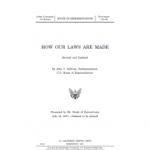A lesson plan for one 80-minute class at the AP level. In it students will identify the main steps in the process of creating and passing legislation:
-Explain the significance of party control and committee work in the Congress in the legislative process
-Identify the role that Congressional leaders such as the House of Representatives and the Senate Majority Leader play in the process of agenda-setting
-Identify the role the President plays in the law-making process
-Explain the reasons why the Founders intended the law-making process to be difficult
The Legislative Process
Nine videos explain each of the common legislative stages, and that the process by which a bill becomes law is rarely predictable.
The Amendment Process: Ratifying the 19th Amendment
In this activity, students will analyze historical records of Congress and the U.S. government to understand the sequence of steps in the amendment process. Students will study each document and match it to the step in the process that it illustrates.
When put in proper sequence, the documents will show the process by which the 19th Amendment – prohibiting the federal government or states from denying the right to vote on the basis of sex – was added to the Constitution.
Then students will reflect on the process, and the roles that the people, president, Congress and the states play.
Congress at Work: The Legislative Process
Congress and the Legislative Branch: Lesson Plans & Resources

This Share My Lesson collection provides free lesson plans and resources to support teachers in educating students about the legislative branch of Congress. Students will learn about the powers of Congress and state legislatures, how those powers have been used or changed over time, and what issues face Congress today.
How Our Laws Are Made

A text-based guide to the workings of Congress and the Federal lawmaking process from the source of an idea for a legislative proposal through its publication as a statute. As the majority of laws originate in the House of Representatives, the publication focuses principally on that body. This guide enables readers to gain a greater understanding of the Federal legislative process and its role as one of the foundations of the United States of America’s representative system of government.
Congress in a Flash! (Lesson Plan)
Need to teach the legislative branch in a hurry? This lesson is designed to cover the basics in a single class period. Students learn what Congress is, what the Constitution says about the legislative branch, and how a bill becomes law. They analyze some actual language from the Constitution, compare the House and the Senate, and simulate the lawmaking process by reconciling two versions of the same fictional bill. This lesson is one in a series entitled “The Legislative Branch.”
The Case of the Murdered Bills
This is a choose-your-own-adventure mystery for deducing how five bills were killed in the legislative process. Assist Henry the intrepid Senate Page in this hard-boiled whodunit!
Congressional Power of Impeachment
In the Constitution, the Congress is given the sole power of impeachment and removing the President and all civil officers from office. This power of Legislative Branch provides a significant check over the Executive and Judicial Branches. This lesson provides explanations of the Constitutional basis of the power, the process for removing officials and the history of impeachments and removing these officials from office. It also provides discussions on the standards of impeachments and how those are interpreted by Congress.

